Photography arrived in India in the late 19th century. Not surprisingly, this shiny new, not to mention exorbitantly expensive, medium attracted the attention of India’s maharajas. They were avid collectors of photographic equipment, lifelong patrons to some remarkable Indian photographers and some were self-taught ‘photographer princes’. Indian royalty had a long and fruitful alliance with this marvelous invention. The form too took ingenious new shapes under the benevolent eye of these patrons and sub-genres that were distinctly Indian began to find expression.
The Pioneers at Tripura
The Dev Burman dynasty, considered to be the last surviving royal line of the northeast, pioneered the spread of photography in India. King Bir Chandra Manikya Dev Burman, who reigned from1862 to1896, acquired one of the first two cameras that came to India—the other is believed to have been bought by Lala Deen Dayal. He was a keen photographer and set up his own studio and darkroom in the palace, importing chemicals, glass plates and other accessories from Europe. He began the Camera Club of the Palace of Agartala, which organised regular exhibitions and contests. He even tutored his 13-year-old Manipuri queen Khunam Chanu Monmohini in the art of photography, eventually holding exhibitions of their works together.
An interesting portrait of the royal couple survives today. Framed against a plain backdrop, they’re caught in a very intimate pose (rather unusual for royalty). This 1880 photograph was likely shot using a long wire shutter control, making it possibly the first ‘selfie’ of an Indian couple!
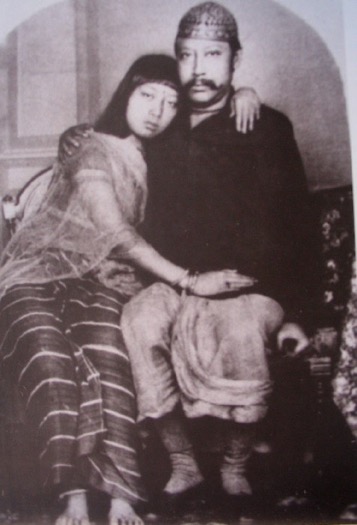
Maharaja Bir Chandra Manikya and Manamohini Devi of Tripura
The Photographer Prince of Jaipur
Around the same time as the king of Tripura was attempting his couple-selfie, another prince, sitting by the jharokhas of Jaipur, was teaching himself photography. Maharaja Sawai Ram Singh II, who reigned from 1835 to 1880, was only two years old when he became the ruler of Jaipur. The story of his first encounter with photography is shrouded in mystery. For the longest time, so was his archive of photographs.
For centuries, over six thousand photographs and thousands of glass plate negatives lay hidden in the dark and dusty cupboards of the Jaipur city palace. Discovered in the late 1900s by the then-keeper of the museum, Yadvendra Sahai, this collection is now one of the most prized possessions of the Maharaja Sawai Man Singh II Museum in Jaipur.
A self-taught photographer, Sawai Ram Singh II was always up-to-date with the latest camera models and accessories, and would often be found in his small retreat called the ‘photu ka karkhana’ or ‘tasveer khana’ – taking pictures, processing them, fixing his chemicals or making regular journal entries about processes. As a ruler, he was a visionary and was singularly responsible for bringing Jaipur to the brink of modernism. Along with other royal projects he commissioned for the kingdom, Ram Singh also envisioned a new museum (the core collection of which later became the Albert Hall Museum) and the Maharaja School of Arts, which taught a module on photography.
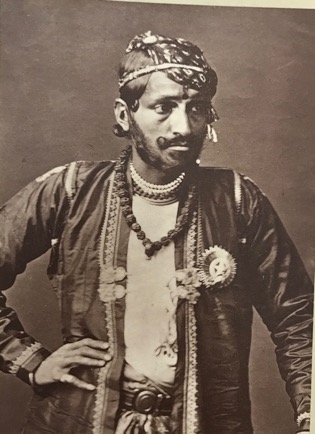
Maharaja Sawai Ram Singh II © Sarmaya Arts Foundation
A most fascinating lot among Ram Singh’s large photographic oeuvre is the ‘zenana portraits’. With portraits of matronly dutikas (go-betweens), favourite paswaans (a concubine who has borne a child) and pardayats (other concubines) of the king—this is the most extensive photographic documentation of zenana women ever to have been carried out by anybody in India. The women in these photographs seem to be all from the royal harem, and the favoured ones appear more than once in various poses and costumes. Interestingly, none of his queens were ever photographed (perhaps because they lived in extreme orthodoxy and behind the purdah, and there was a widespread superstition at the time that a camera stole a part of the subject’s soul).
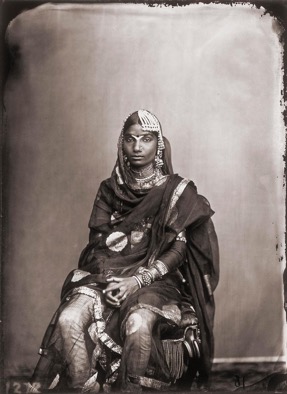
Portrait of a woman from Ram Singh’s zenana. Many photographs of this particular woman have been found, and she may be putatively identified as ‘Ram Sukee’. She was perhaps a favourite paaswaan (a concubine who has borne a child). Image courtesy: Maharaja Sawai Man Singh II Museum, Jaipur
Another notable set of images from Ram Singh’s works are his self-portraits. The extensive amount of time and energy invested in this singular pursuit is evident in the elaborate set-up, costumes and technical dexterity that the prince exhibits in these images. He’s taken photographs of himself saying his morning prayers and dressed as a Brahmin or readying for durbar in his royal regalia or sitting in his library wearing the air of a learned scholar. Some of these also show assistants helping him—unamused men stretching the plain cloth behind the sitter, crouching on the floor to hold up painted backgrounds and, because the negatives were never cut, offering tantalising peeps into what Ram Singh’s studio must have looked like behind this staged setting!
The organic rawness of these images is what makes them so captivating. You feel like you can reach inside these scenes and experience a day in the life of the photographer prince and his Jaipur thikana.
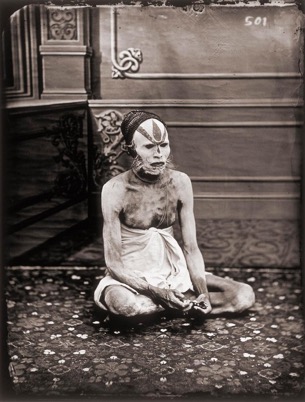
Portrait of a Fakir with a painted backdrop at the palace studio. Image courtesy: Maharaja Sawai Man Singh II Museum, Jaipur
The Arrival of Hand-Painted Photographs
Photography quickly came to replace painting in India as the go-to option for capturing likenesses and creating portraits. As Indian royalty ‘ooh-ed and aah-ed’ over box cameras and albumen prints, an entire generation of court painters suddenly found themselves out of a job. With no royal portraits to paint and no miniatures commissioned to commemorate fights and hunts, these artists had to devise alternate ways and develop new skills to support themselves. Enter the painted photograph!
The hand-painting of photographs had been around in the western world but the process was limited there to adding subtle highlights or making minor corrections. Here however, the technique took a unique and characteristically ‘Indian’ turn. Despite their initial infatuation with the medium, Indian royals soon started to feel something was missing in these black-and-white images. Something of the grandeur and magnificence of their robes, jewels and palaces were getting lost in translation. This is when a merger of two distinct art-forms occurred and court painters were employed to apply paint over photographs. The new arrangement suited the Indian princes very well as they got the best of both worlds: a quick and honest re-creation of their likenesses, and a highly embellished final product, courtesy the miniaturist.

Painted photograph of Maharana Bhupal Singh of Udaipur: An example of photographic experimentation. The king was crippled at a very young age and could not stand straight. Here, the painter has taken the freedom that the medium provides to portray him standing upright. Image © Sarmaya Arts Foundation
Trained in the traditional styles of miniature painting, these artists captured the minute details of the royal ornaments, tapestries and interiors. Sometimes the entire surface of the image would be painted over (only leaving the face and hands bare) and it soon became impossible to tell a painting from a photograph. The artists also experimented by painting backdrops over the photograph, applying paint on the negative directly before processing and even creating photo collages.
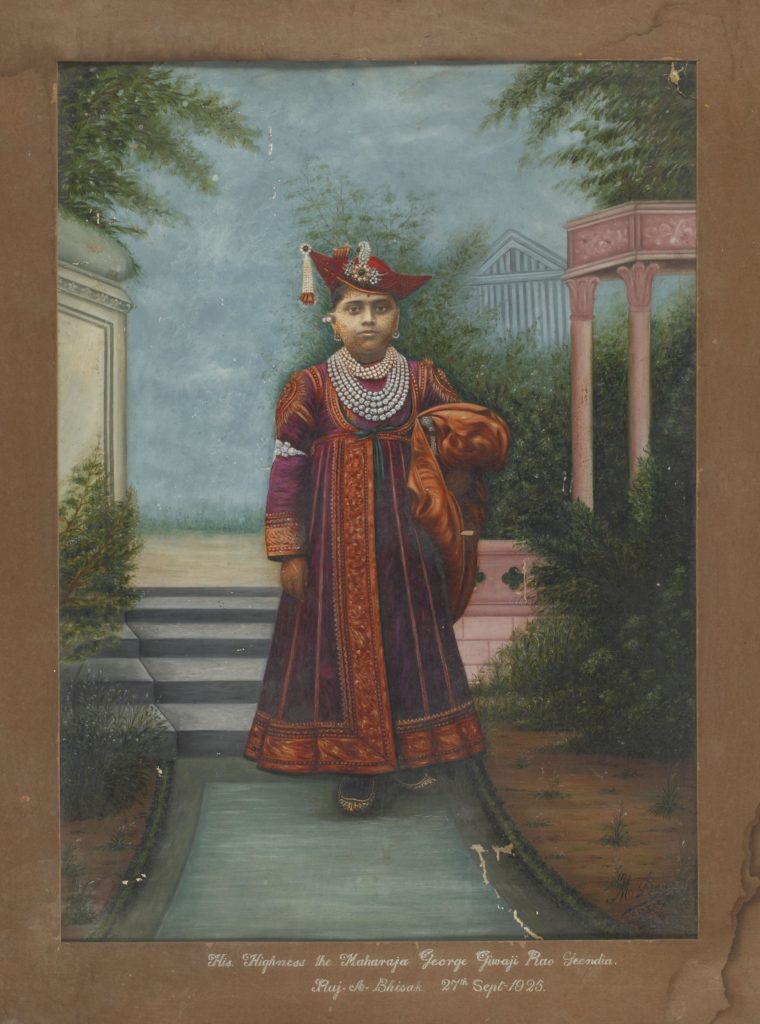
Painted Photograph of Jiwaji Rao Scindia of Gwalior. Notice how the backdrop has been painted over the photograph. Here, the setting is that of a European garden. Some rudimentary architecture is in place but the rest of the space is left blank. Look closer at the young prince’s face and you can see traces of the photo appearing under the paint that’s peeling off. Image © Sarmaya Arts Foundation
Shubhasree Purkayastha is Curatorial and Research Associate at Sarmaya



